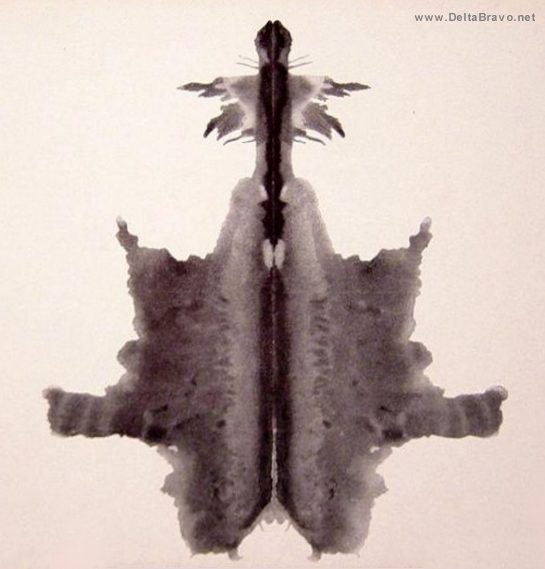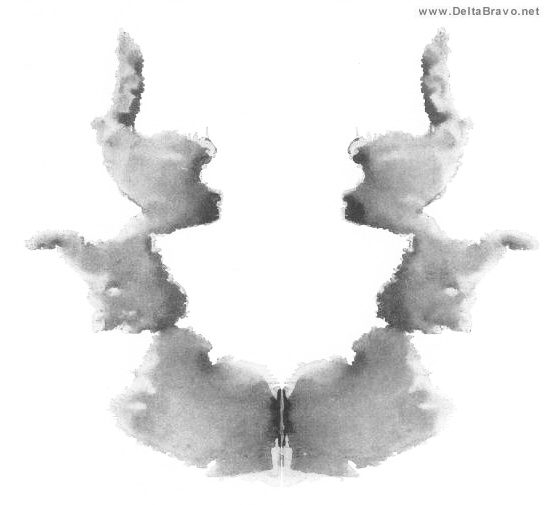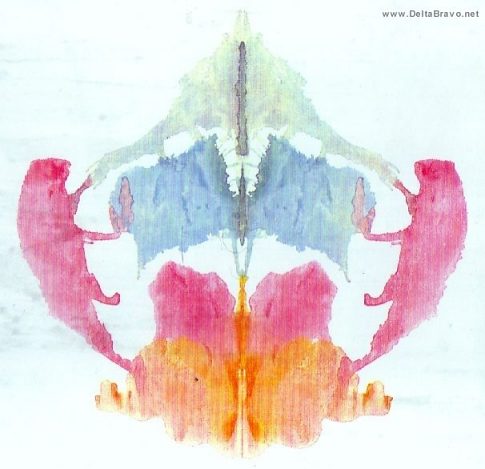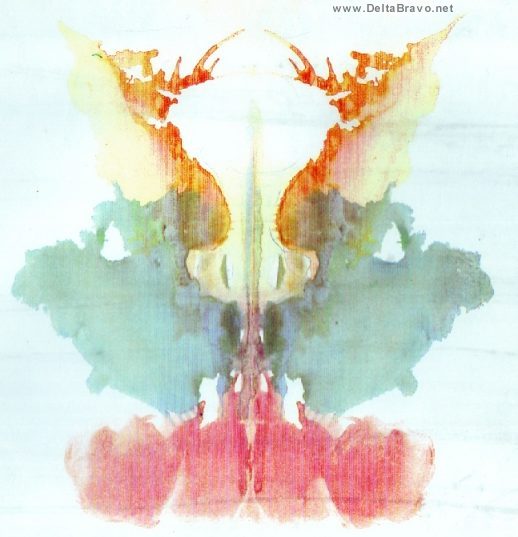- Welcome to SPARC Forums.
May 05, 2012, 11:58:00 AM
Views: 321153
After repeated letters from dozens of outraged psychologists and psychiatrists claiming that this page
"violates the copyright on the Rorschach Test", we feel compelled to post this notice:
"violates the copyright on the Rorschach Test", we feel compelled to post this notice:
The information presented here, including the actual Rorschach inkblots, is not in violation of copyright law. Please don't waste your time writing us to complain or threatening to "turn us in to the publisher". They are in the public domain under United States copyright law based on when they were first created and published (before 1923), as well as in countries with a copyright term of up to 70 years post mortem auctoris [1].
Disclaimer Of Use
Reading the information provided here could compromise the administration of the Rorschach test, invalidating your answers. If you don't wish to take the Rorschach test (and we suggest NOT taking it in the context of a custody dispute if at all possible), tell the psychologist that you are familiar with the Rorschach test, have read about the test and have seen the inkblots. Any ethical psychologist will decline to administer the test upon learning this, and the issue of the test's validity will be a moot point.
Please note that the sample responses shown below are not necessarily "good" responses to the Rorschach. They are sample responses provided only for purposes of illustration, and we don't advise anyone to use the sample responses. What we advise is that you DO NOT take a Rorschach test for any reason.
SPARC's position on the use of the Rorschach test is that it is an inappropriate and unreliable test for use in the context of a child custody evaluation, and that tests such as the Bricklin series or the MMPI-2 are more suitable and more reliable for use personality evaluations in custody disputes.
The Rorschach test (pronounced "ror-shock") has been popularized in films and books for decades, but most people know very little about it. The Rorschach cards themselves are supposed to be kept secret although outlines of them can be found on various websites and in medical texts. We display the actual cards, not just the outlines. (Note that most of the time when you see Rorschach ink-blots in films and books, they are not the real blots.)
Blot Confidentiality
The Rorschach ink blots are supposed to remain secret so as not to "pollute" the test population (people to whom the test is given to). The theory behind the test, created by Hermann Rorschach, is that the test taker's spontaneous or unrehearsed responses reveal deep secrets or significant information about the taker's personality or innermost thoughts. These days most reputable psychologists feel the Rorschach is unreliable at best and dangerously misleading at worst. A few psychologists still believe in it as a valid diagnostic tool, however, despite the availability of more modern, sophisticated personality tests. The psychologists who do still see value in it frequently argue amongst themselves as to the manner of its interpretation, the meaning of the results, and even its validity. In addition, several different schools of thought have sprung up for the of "interpretation" of the results, muddying the waters even further. The "Exner Comprehensive System" for the Rorschach is one of the more popular scoring methodologies in use today.
Rorschach Test Administration
The Rorschach test is supposed to be administered in a very rigid way with a particular "format" or protocol in order to minimize variances in the results. (Like the cards themselves, the test procedure itself is also supposed to be kept secret from the general public, by the way.) In general, questioning or asking about the results is supposed to have significance to the test provider, as does asking nearly anything about the blots themselves. For example, asking if you can turn the card around "means" something to the test giver.
The test giver will rarely if ever give you any guidance; they will instead tell you that you're free to do whatever you like with the card (flip it, tilt it, lay it down, etc). About 50% of people who take the test do flip or rotate the cards, and the psychologist is supposed to note anything and everything you do with them. It's reported that some psychologists will penalize you (in terms of the results) if you don't turn the cards around or upside-down. All in all, it's a very odd thing to score people on, and the Rorschach is practically the only test that uses a metric like this.
Taking The Test
In the standard test protocol you are given the cards one at a time in a specific order, and the psychologist is supposed to place them directly in your hands facing "up" and in a particular orientation. The order is not supposed to vary. The genuine Rorschach cards are numbered on the back primarily for the psychologist's use. If you notice the numbers or remark on them, a note is supposed to be made about this. The cards themselves are large, about 6 3/4 by 9 inches and are made of a stiffened cardboard or, in modern variations, a textured plastic that mimics the feel of cardboard. Five of the cards have purely black and white images, two of the cards are black, white, and red, and the last three cards have various colors of ink used in the blots.
During the test the psychologist or psychiatrist will record everything you say; some use a tape recorder so they can extract more detailed notes later, after the test is over and you have left. It used to be that the notes were taken in a special shorthand that was specifically developed for the Rorschach test, although these days many psychologists rely more on tape recordings and will only make cursory hand-written notes during the test. Often the psychologist will attempt to shield his or her note-taking from you so as not to distract you or make you nervous (presumably skewing the test results).
Response Time
The time it takes you to provide a verbal response is carefully noted, along with any other secondary comments you may make. Hand gestures and some body movements may also be noted. In the classical test protocol the psychologist is never supposed to "hurry you along" or ask you to respond. Again, tape recordings often serve the examiner well in this regard since they can time the responses later (and with more accuracy) at their leisure.
Your Responses
According to some psychologists, stating "This is a..." constitutes a "bad" response. You are supposed to know that the cards don't actually represent any recognizable figures, so saying something like "This looks like ..." is considered a more "healthy" response. When you think about it, this preoccupation with literalness is rather silly. No one who says "This is..." in response to a card really thinks that's what the card is actually an image of. If they did they would likely be too mentally disordered to even take the test in the first place.
Some psychologists and psychiatrists feel that tilting the card at an angle is a "bad" response (or at least an "unhealthy" one). Likewise, trying to be a smart-ass and stating that "This is just an ink blot" is considered a very bad response. Making noises or covering up parts of the card also counts against you- this may even be taken as an indication of possible brain damage. (Interestingly enough, making an exasperated noise in a meeting or covering up part of a spreadsheet to visualize it better aren't usually considered signs of brain damage. Go figure.)
Good Answers And Bad Answers
What is a "good" answer versus a "bad" answer? This is a tricky question, and even the psychologists who swear by the Rorschach test don't agree on this (although there is some agreement on what constitutes a really bad answer). Your best bet is probably to stick to "seeing" healthy, friendly images. Avoid dark or violent answers ("I see Satan eating a baby's brain!"). Butterflies, people holding hands, leaves, mountains, etc are all generally considered to be "safe" responses (although nothing is guaranteed when taking the Rorschach). If you can show how a particular shape really does resemble something, go ahead and say so. If you come up with a novel or particularly interesting answer you may get "points" for your creativity. The fact is, however, that in the end it's mostly up to the examiner as to how your responses are interpreted. This is in direct opposition to more objective tests like the MMPI or MMPI-2
Don't try and be outlandish, provocative, obstinate, or oppositional- these won't curry any favor with the test giver (and will in fact typically count against you). Overly-sexualized answers or imagery will, as you might suspect, be noticed and generally scored against you.
Taking an excessively long time to answer or answering immediately (not taking any time to ponder the card at all) will virtually always count against you. Just how much will be up to the examiner, but both ultra-quick responses as well as slow or "tardy" responses to the Rorschach cards are considered "bad". Responding instantly will more than likely do little more than get the examiner pissed off at you. Taking too long to answer may frustrate them or try their patience.
Shapes And Visualization
Some psychologists feel that you should see a limited range of shapes or "items" in each particular card. Seeing radically different things than the typical responses or claiming to see nothing at all will definitely be held against you in terms of Rorschach scoring, and may result in a finding of "retardation" or a possible mental disorder. Seeing lots of different things in the card may also be taken as a sign of cognitive problems or even schizophrenia. By now you should be getting the idea that basically it's hard to "win" when taking the Rorschach test.
In "Follies Of The Wise", Frederick Crews studied the Rorschach test and was not impressed. Crews writes:
"Movement- and color-based responses were of paramount importance in Rorschach's system of weighing personality. He believed that test takers who offer a high number of movement ("M") responses are, paradoxically, turned inward or "introspective"; intelligent and creative, they are nonetheless awkward and socially inept. In contrast, subjects who favor color ("C") responses are "extrasensitive," or adroit in company but restless and impulsive. Someone who registers a high number of both M and C scores qualifies ad "dilated" or "ambiequal" -a healthy blending of introspective and extra sensitive traits. But low and similar numbers of M and C responses stigmatize the subject as "coarctive," or lacking in both creativity and emotional stability.
"...Bizarrely, for example, he (Rorschach) insisted that a movement response be scored if the subject conjured a child sitting at a desk or a vampire sleeping in a coffin, because "muscular tension" was supposedly implied. And although a dog performing in a circus exhibited Rorschach movement, a cat catching a mouse or a fish darting through water did not, because, according to the founder, significant motion had to be "human-like" in function."
Rorschach also applied the quality of "pedants" or "grumblers" to test takers who paid attention to details rather than the overall images, and people who paused before commenting on the colored cards (but not the black and white ones) were supposed to be displaying "color shock", which in turn meant (of course) that they were "neurotic repressors" of emotion.
The Rorschach Ink Blots
We'll show you the actual cards below. The cards are numbered 1 through 10, and that is the order in which they're always given to you by the psychologist.
Please note that some personal firewall products may prevent these images from appearing.
If this occurs, disable your firewall temporarily to view the images.
If this occurs, disable your firewall temporarily to view the images.

Plate I
This is a black and white card, often described as looking like a mask or the face of a fox or wolf.
Possible Sexual Imagery: Breasts, primarily the rounded areas at the top of the image.

Plate II
This is a card with black and red ink, often described as people dancing or touching hands with each other.
Possible Sexual Imagery: Male sex organ at top center or, in some cases, a vagina (at the center near the bottom).

Plate III
This is a card with black and red ink, frequently visualized as two people facing each other or sometimes a butterfly or moth.
Possible Sexual Imagery: Male sex organs and female breasts, right about where you would expect to find them.

Plate IV
A card with only black ink formed in a triangle-shaped blot. The two lower corners are often described as shoes or boots. This card may also be seen as viewing a person from below or a male figure with an enormous sex organ.
Possible Sexual Imagery: A pair of male sex organs, typically seen at the top of the image. Some subjects may instead visualize a vagina in the upper center of the blot.

Plate V
Another card with only black ink. The vast majority of test subjects will see a bat- or bird-like figure. This is by far the most common response.
Possible Sexual Imagery: A pair of male sex organs at the very top of the inkblot.

Plate VI
A card with black ink showing an amorphous "splat" shape. This one can be hard to see anything in. Occasionally described as a foreshortened view of a person with their arms outstretched.
Possible Sexual Imagery: The head of the male sex organ (the portion at the top of the card) or alternately, a female sex organ (middle and bottom part of the card).

Plate VII
A card with only black ink. This card has a rough "V" shape sometimes described as faces pointing towards one another, "bunny ears", or similar visualizations.
Possible Sexual Imagery: The female sex organs (seen at the bottom of the card where the figures join.

Plate VIII
A very colorful card with blue, orange, pink, and gray ink. A roughly diamond-shaped image with lots of places to see things- a mask, animals climbing up the outsides, a moth or butterfly, a person with their arms akimbo, etc etc.
Possible Sexual Imagery: Female sex organs, usually seen at the bottom of the card.

Plate IX
Another colorful card, this time with orange, pink, and green inks. This one is tough to visualize anything specific in; most test subjects struggle to find something to "see" in it.
Possible Sexual Imagery: Female sex organs, usually seen at the bottom of the card.

Plate X
This is the last Rorschach card and certainly the most colorful, consisting of blue, gray, pink, green, orange and yellow inks. It's a very complex mish-mash of shapes with lots of "activity" and plenty of places to "see" things.
Possible Sexual Imagery: Male sex organs at the top center of the card.
Additional Notes:
Many professionals feel that the Rorschach is outdated, inaccurate, and meaningless. For example:
"Nobody agrees how to score Rorschach responses objectively. There is nothing to show what any particular response means to the person who gives it. And, there is nothing to show what it means if a number of people give the same response. The ink blots are scientifically useless." (Bartol, 1983).
"The only thing the inkblots do reveal is the secret world of the examiner who interprets them. These doctors are probably saying more about themselves than about the subjects." (Anastasi, 1982).
What these comments seem to indicate is that the Rorschach is potentially unreliable, easily misinterpreted, and essentially not a valid means of determining what it claims to detect. For more information on the use and potential unreliability of the Rorschach test (including comments sent in to us by mental health professionals) read the Additional Rorschach Information page and "Misuse of Psychological Tests in Forensic Settings: Some Horrible Examples" by Ralph Underwager and Hollida Wakefield.
"...I used and taught Rorschach for 20 years. I abandoned the test circa 1998 consequent to Woods et al fine articles on the subject of projective testing. I had previously abandoned use of all other projectives circa 1990 simply because they failed to enrich my understanding of people and were also often, frankly, wrong or misleading."
Another point worth noting is that even the APA doesn't condone the use of 'outdated' tests, which the Rorschach would certainly qualify under:
APA ETHICAL PRINCIPLES OF PSYCHOLOGISTS AND CODE OF CONDUCT
https://www.apa.org/ethics/code.html
https://www.apa.org/ethics/code.html#2.07
2.07 Obsolete Tests and Outdated Test Results.
(a) Psychologists do not base their assessment or intervention decisions or recommendations on data or test results that are outdated for the current purpose.
(b) Similarly, psychologists do not base such decisions or recommendations on tests and measures that are obsolete and not useful for the current purpose.
You may view this page for more on the Rorschach Test: Additional Rorschach Information
Finally, if you like, you may also take the Rorschach test online at either of the sites below:



